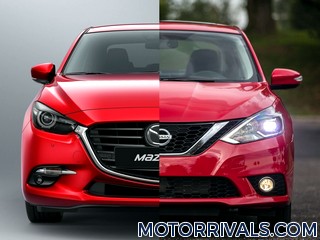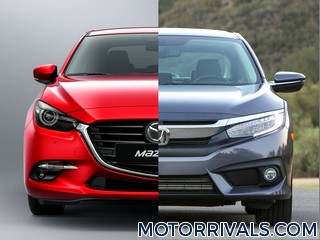2017 Mazda 6 vs 2017 Honda Accord
Mazda Press Release Highlights
Mazda is looking to do no less with the 2017 Mazda 6 than deliver a flagship offering a foundation for the perfect driver-car relationship. It is a rather simple concept: The driver provides input via controls like the steering wheel, pedals and gearshift. The vehicle, meanwhile, does what it's told and supplies feedback. Mazda is continually striving to perfect the concept, because effective communication between man and machine not only makes driving safer, but also more satisfying, more rewarding and more fun. Mazda calls this relationship Jinba Ittai, and to continue enhancing the "oneness" of driving its flagship, the carmaker looked at things from the customer perspective.
Mazda takes a human-centered approach to balancing the conflicting characteristics of agile handling and a refined ride, since they directly affect the Jinba-Ittai nature of all its products. Introducing SKYACTIV-VEHICLE DYNAMICS. For occupants' well-being, the interior packages offer a level of sophistication, quality and comfort is indeed fitting for an upmarket flagship, and every bit up to the award-winning looks. The carmaker has clearly achieved what it was aiming for with the 2017 Mazda 6, namely a degree of attractiveness and a personality that outclasses its class with a human-oriented approach to premium that is uniquely Mazda.
Both SKYACTIV-D 2.2 versions feature a sequential twin turbocharger, delivering outstanding toque without turbo lag, as well as the fuel-economy advantages of optimum combustion timing, specially shaped pistons, multi-hole piezo injectors and more. These unconventional diesels are now more responsive and quieter than ever, too, with three new systems for the SKYACTIV-D 2.2 making their debut on the 2017 Mazda 6.
The SKYACTIV-G petrol engines are likewise a product of Mazda's non-stop efforts to continue advancing the Jinba-Ittai driving sensation. Like the SKYACTIV-D, this means smoothly delivering the ideal linear response to driver input, behaving precisely as intended and providing the corresponding feedback.
The engines are mated to six-speed SKYACTIV-Drive automatics or SKYACTIV-MT manual transmissions. i-stop, idle stop system providing some of the fastest restarts around, is standard equipment, while i-ELOOP, Mazda's unique brake energy regeneration system, is available for all power plants except the 145PS version of the SKYACTIV-G 2.0. Diesel-powered Mazda 6 wagons are also offered with Mazda's intelligent i-ACTIV AWD system, which features a front-slip detection warning system.
The 2017 Mazda 6's SKYACTIV-Chassis plays an elemental role here. It features a front MacPherson strut and rear multi-link suspension whose shock absorber structure and optimized bushing shapes to deliver a flatter, smoother ride, balancing steering comfort and fun responsiveness as well as braking agility and stability. Lightweight yet exceptionally stiff, the SKYACTIV-Body, meanwhile, supports the reconciliation of these contradictory factors. Despite having one of the lowest curb weight in its class (starting at 1,300kg), the Mazda 6 also delivers top-class passive safety protection that helped it earn five stars from Euro NCAP and other traffic safety authorities around the world. Aerodynamics are outstanding too, with cd values of 0.26 for the sedan and 0.28 for the wagon.
Mazda Radar Cruise Control (MRCC) uses the aforementioned microwave radar to monitor preceding motorists and maintain a safe trailing distance (pre-determined by the driver) by adjusting throttle and brake pressure. Driver Attention Alert (DAA), meanwhile, keeps an eye on the driver and recommends a break every two hours or sooner should it recognize any noteworthy changes in behavior. Finally, the 2017 Mazda 6 also features Emergency Stop Signal (ESS), which automatically flashes the four-way hazard lights during heavy braking, and Hill Launch Assist (HLA), which prevents rolling during hill starts. ABS with EBD (electronic brake distribution), EBA (brake assist), DSC (dynamic stability control) and TCS (traction control system) are all standard equipment.
Mazda takes a human-centered approach to balancing the conflicting characteristics of agile handling and a refined ride, since they directly affect the Jinba-Ittai nature of all its products. Introducing SKYACTIV-VEHICLE DYNAMICS. For occupants' well-being, the interior packages offer a level of sophistication, quality and comfort is indeed fitting for an upmarket flagship, and every bit up to the award-winning looks. The carmaker has clearly achieved what it was aiming for with the 2017 Mazda 6, namely a degree of attractiveness and a personality that outclasses its class with a human-oriented approach to premium that is uniquely Mazda.
Powertrain
The Mazda 6 comes with a choice of two SKYACTIV-D 2.2-litre diesels (150PS & 175PS) and three petrol engines: the SKYACTIV-G 2.0 with 145PS or 165PS, and the 192PS SKYACTIV-G 2.5. Featuring extreme compression ratios of 14:1 for all but one - much lower than the competition's diesels and exceptionally high for petrol engines - they not only get the job done and do it efficiently, but they also engage the driver while they're at it thanks to lightweight innovation and efficient packaging.Both SKYACTIV-D 2.2 versions feature a sequential twin turbocharger, delivering outstanding toque without turbo lag, as well as the fuel-economy advantages of optimum combustion timing, specially shaped pistons, multi-hole piezo injectors and more. These unconventional diesels are now more responsive and quieter than ever, too, with three new systems for the SKYACTIV-D 2.2 making their debut on the 2017 Mazda 6.
The SKYACTIV-G petrol engines are likewise a product of Mazda's non-stop efforts to continue advancing the Jinba-Ittai driving sensation. Like the SKYACTIV-D, this means smoothly delivering the ideal linear response to driver input, behaving precisely as intended and providing the corresponding feedback.
The engines are mated to six-speed SKYACTIV-Drive automatics or SKYACTIV-MT manual transmissions. i-stop, idle stop system providing some of the fastest restarts around, is standard equipment, while i-ELOOP, Mazda's unique brake energy regeneration system, is available for all power plants except the 145PS version of the SKYACTIV-G 2.0. Diesel-powered Mazda 6 wagons are also offered with Mazda's intelligent i-ACTIV AWD system, which features a front-slip detection warning system.
Chassis
Debuting in Europe as standard equipment on the 2017 Mazda 6 and 2017 Mazda 3, the first system in the new SKYACTIV-VEHICLE DYNAMICS line-up is G-Vectoring Control (GVC). By optimizing the vertical load on the tires to the given conditions, it keeps the vehicle on its intended path while significantly reducing the need for steering correction.The 2017 Mazda 6's SKYACTIV-Chassis plays an elemental role here. It features a front MacPherson strut and rear multi-link suspension whose shock absorber structure and optimized bushing shapes to deliver a flatter, smoother ride, balancing steering comfort and fun responsiveness as well as braking agility and stability. Lightweight yet exceptionally stiff, the SKYACTIV-Body, meanwhile, supports the reconciliation of these contradictory factors. Despite having one of the lowest curb weight in its class (starting at 1,300kg), the Mazda 6 also delivers top-class passive safety protection that helped it earn five stars from Euro NCAP and other traffic safety authorities around the world. Aerodynamics are outstanding too, with cd values of 0.26 for the sedan and 0.28 for the wagon.
Technology
The heads-up interior introduced on the 2015 model intensified the Jinba Ittai connection with the car with a uniquely ergonomic layout of all driving-related controls. The advanced on-board systems do provide a lot of information. To make it all simpler to digest, the carmaker replaced the monochrome Active Driving Display, as Mazda calls its head-up display, with a full-color system. The multi-information gauge on the right side of the instrument cluster gets a similar treatment in the name of better display quality, easing comprehensibility with full-color TFT LCD technology offering more realistic graphics, icons and animation. The climate control system, meanwhile, adds sensors to enable more precise temperature regulation. It also switches to recirculated air when the engine is cold for faster warm-ups, especially in winter, thus saving fuel.Safety
The Mazda Proactive Safety concept starts with i-ACTIVSENSE, which is Mazda's advanced active and pre-crash safety technology. Three i-ACTIVSENSE advancements debut including Advanced Smart City Brake Support (Advanced SCBS), Smart Brake Support (SBS), and Traffic Sign Recognition (TSR). The 2017 Mazda 6 also includes Blind Spot Monitoring (BSM) and Rear Cross Traffic Alert (RCTA), which uses BSM's sensors and signals when the car is reversing. Lane-keep Assist System (LAS) monitors the road markings. Adaptive LED Headlights (ALH) combines glare-free LED high beams and wide-range low beams with an auto-levelling function.Mazda Radar Cruise Control (MRCC) uses the aforementioned microwave radar to monitor preceding motorists and maintain a safe trailing distance (pre-determined by the driver) by adjusting throttle and brake pressure. Driver Attention Alert (DAA), meanwhile, keeps an eye on the driver and recommends a break every two hours or sooner should it recognize any noteworthy changes in behavior. Finally, the 2017 Mazda 6 also features Emergency Stop Signal (ESS), which automatically flashes the four-way hazard lights during heavy braking, and Hill Launch Assist (HLA), which prevents rolling during hill starts. ABS with EBD (electronic brake distribution), EBA (brake assist), DSC (dynamic stability control) and TCS (traction control system) are all standard equipment.
Honda Press Release Highlights
Crisply styled and aerodynamically efficient, the ninth-generation Honda
Accord Sedan and Accord Coupe body designs and engineering features are
the most sophisticated in the Accord nameplate's history. Every aspect
of the body is tailor-made to improve every aspect of the Accord
ownership experience, from more precise ride and handling to a quieter
interior environment, along with enhanced visibility and increased fuel
efficiency. The Accord's uni-body uses a large percentage of
high-strength steel, which gives the Accord high structural strength for
improved ride quality and more precise cornering. The Sedan's body
design is bold and decisive, sleek and fluid, while the Coupe body
design is rakish, taut and athletic. In both body styles, extensive use
of aerodynamic detailing, including expanded use of under-covers,
improves the Accord's aerodynamic efficiency, which directly benefits
fuel efficiency. For 2016, development work on the ninth-generation
Accord sedan body has centered on increased rear body rigidity in order
to significantly improve both ride quality and handling. Particular
attention has been paid to increased torsional rigidity with incremental
improvements in bending and lateral rigidity as well. Development work
centered on how to further smoothen the flow of air both under and
around the sides of the body. The Accord Sedan and Coupe both get a
major facelift. All Accord models feature sportier, more
sophisticated and expressive styling cues, including restyled front and
rear bumpers fasciae, a new grille and new taillight designs, as well as
new aluminum wheels for all models and trims.
The direct-injected 2.4-liter i-VTEC inline 4-cylinder powerplant is the base Accord engine, providing 185 horsepower and 181 lb-ft. of torque. With its high-flow exhaust system, the Accord Sport Sedan 4-cylinder engine generates 189 horsepower and 182 lb-ft. of torque.
The available 3.5-liter V-6 engine delivers 278 horsepower at 6200 rpm and 252 lb-ft. of torque at 4900 rpm. On V-6 models with 6-speed automatic transmission, the engine also features Variable Cylinder Management (VCM) variable displacement technology. Depending on driving conditions, the engine operates on three or six cylinders to help boost fuel efficiency or power as needed.
The V-6 engine can be paired with a smooth-shifting 6-speed manual transmission, or a 6-speed automatic transmission with Grade Logic Control. The V-6 is designed to run on regular unleaded fuel, and has an anticipated EPA fuel economy rating of 21/34/26 mpg city/hwy/combined (Sedan).
Accord Touring trims (Sedan and Coupe) get further upgraded Amplitude Reactive Dampers with variable suspension stroke, providing for an even more refined ride quality and improved body control during cornering. The Touring trim also gets new hydraulic rear subframe bushings for reduced high-frequency vibration.
The Accord audio and digital experience is also significantly upgraded for 2016 with the application of a new 7-inch Display Audio touchscreen interface (EX and above trims) featuring Apple CarPlay® and Android Auto, as well as newly available HondaLink Assist (e911) and HD Radio. Smartphone pairing is now simplified with a single USB cable connection, no longer requiring a separate HDMI cable connection. The new Display Audio system serves as the interface for new Apple CarPlay® and Android Auto, offering a multitude of new functions and features, including smartphone-linked navigation (Apple Maps or Google Maps), audio streaming, voice-controlled SMS text messaging and more.
Also, all Accords feature a standard Multi-Angle Rearview Camera and Expanded View Driver's Mirror. Also, for the first time, Touring trims feature new auto high-beam headlights, which enhance nighttime visibility and driving convenience by automatically defaulting to the high-beam setting and switching to low beams when an oncoming vehicle is detected.
Inside, passive-safety features include a total of six airbags, including dual-stage, multiple-threshold front airbags, improved new SmartVent™ front side airbags, and side curtain airbags. The SmartVent side airbag construction helps mitigate the risk of excessive airbag deployment force while eliminating the need for the prior Accord's Occupant Position Detection System (OPDS).
Powertrain
The Accord Sedan and Coupe are offered with two advanced engines - a direct-injected (DI) 2.4-liter inline 4-cylinder engine, and a 3.5-liter V-6 that is the most powerful engine offered in a Honda sedan to date. Available transmissions include a sporty and fuel-efficient continuously variable transmission (CVT) for the 4-cylinder engines, unique 6-speed manuals for the 4-cylinder and V-6 engines, and a 6-speed automatic for V-6 models.The direct-injected 2.4-liter i-VTEC inline 4-cylinder powerplant is the base Accord engine, providing 185 horsepower and 181 lb-ft. of torque. With its high-flow exhaust system, the Accord Sport Sedan 4-cylinder engine generates 189 horsepower and 182 lb-ft. of torque.
The available 3.5-liter V-6 engine delivers 278 horsepower at 6200 rpm and 252 lb-ft. of torque at 4900 rpm. On V-6 models with 6-speed automatic transmission, the engine also features Variable Cylinder Management (VCM) variable displacement technology. Depending on driving conditions, the engine operates on three or six cylinders to help boost fuel efficiency or power as needed.
The V-6 engine can be paired with a smooth-shifting 6-speed manual transmission, or a 6-speed automatic transmission with Grade Logic Control. The V-6 is designed to run on regular unleaded fuel, and has an anticipated EPA fuel economy rating of 21/34/26 mpg city/hwy/combined (Sedan).
Chassis
The Accord received numerous engineering changes to its chassis design with the aim of further improving both ride and handling while creating greater differentiation in the performance characteristics of different models, in particular the Sport Sedan and Touring Sedan and Coupe. All Accords apply higher performance dampers and new compliance bushings. All models get new front and rear high performance dampers designed to offer increased response especially in the initial stage of body movement. Development work has centered on reduced internal friction and increased linearity, resulting in the redesign of the oil channel aiding both ride comfort and handling precision.Accord Touring trims (Sedan and Coupe) get further upgraded Amplitude Reactive Dampers with variable suspension stroke, providing for an even more refined ride quality and improved body control during cornering. The Touring trim also gets new hydraulic rear subframe bushings for reduced high-frequency vibration.
Technology
The new Honda LaneWatch™ display, included on Accord EX, EX-L and Touring Sedan models and EX-L and Touring Coupe, uses a camera located below the passenger-side mirror to display an expanded rear view of the passenger side roadway on the intelligent Multi-Information Display (i-MID).The Accord audio and digital experience is also significantly upgraded for 2016 with the application of a new 7-inch Display Audio touchscreen interface (EX and above trims) featuring Apple CarPlay® and Android Auto, as well as newly available HondaLink Assist (e911) and HD Radio. Smartphone pairing is now simplified with a single USB cable connection, no longer requiring a separate HDMI cable connection. The new Display Audio system serves as the interface for new Apple CarPlay® and Android Auto, offering a multitude of new functions and features, including smartphone-linked navigation (Apple Maps or Google Maps), audio streaming, voice-controlled SMS text messaging and more.
Safety
Featuring a host of new standard and available technologies, the ninth-generation Accord Sedan and Coupe offer a wide range of active and passive safety and driver assistive features and technologies. For 2016, all Accords can be equipped with Honda Sensing™, among the most comprehensive suites of advanced safety and driver-assistive technologies in the midsize class.Also, all Accords feature a standard Multi-Angle Rearview Camera and Expanded View Driver's Mirror. Also, for the first time, Touring trims feature new auto high-beam headlights, which enhance nighttime visibility and driving convenience by automatically defaulting to the high-beam setting and switching to low beams when an oncoming vehicle is detected.
Inside, passive-safety features include a total of six airbags, including dual-stage, multiple-threshold front airbags, improved new SmartVent™ front side airbags, and side curtain airbags. The SmartVent side airbag construction helps mitigate the risk of excessive airbag deployment force while eliminating the need for the prior Accord's Occupant Position Detection System (OPDS).




















